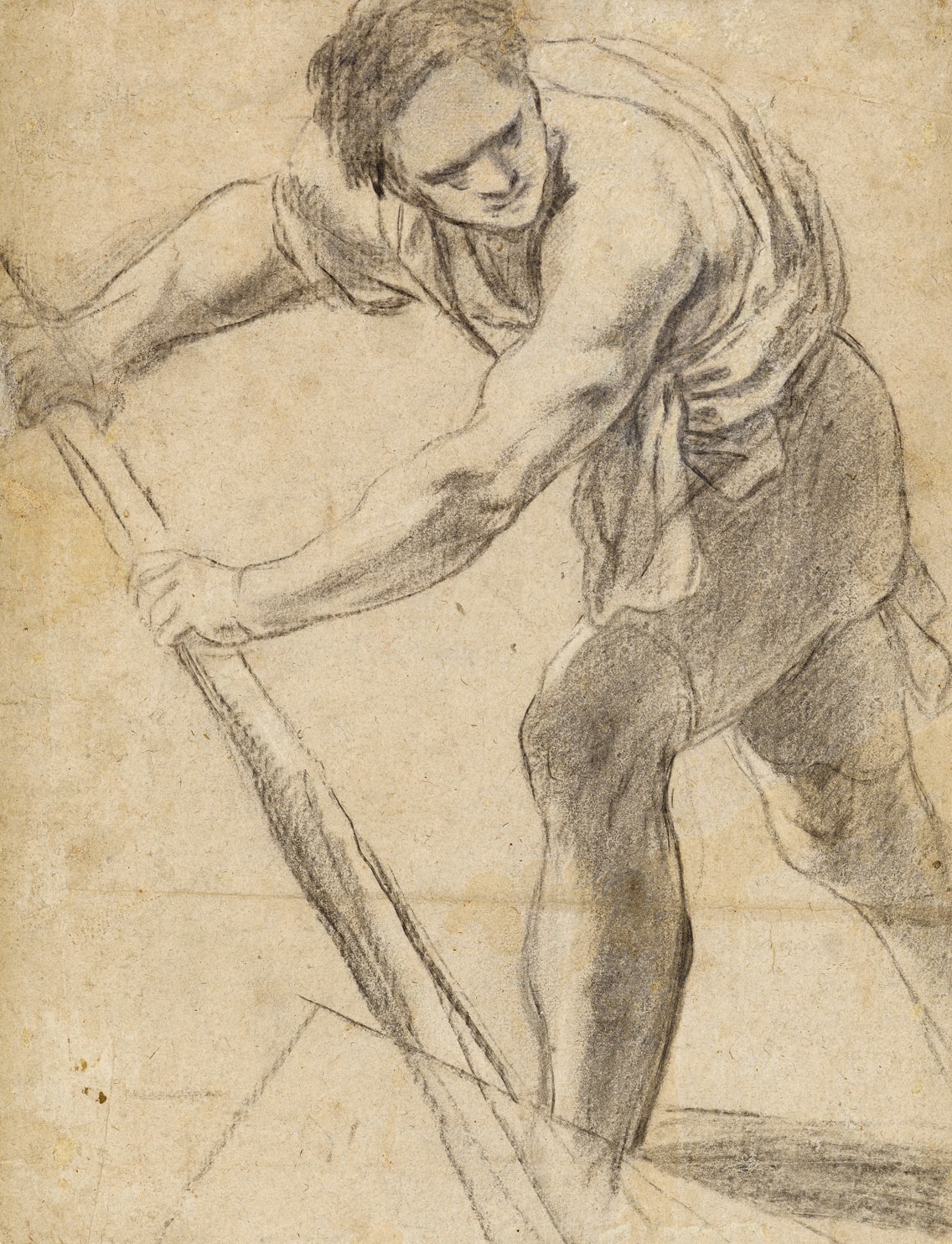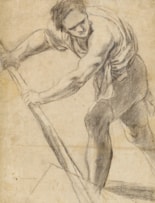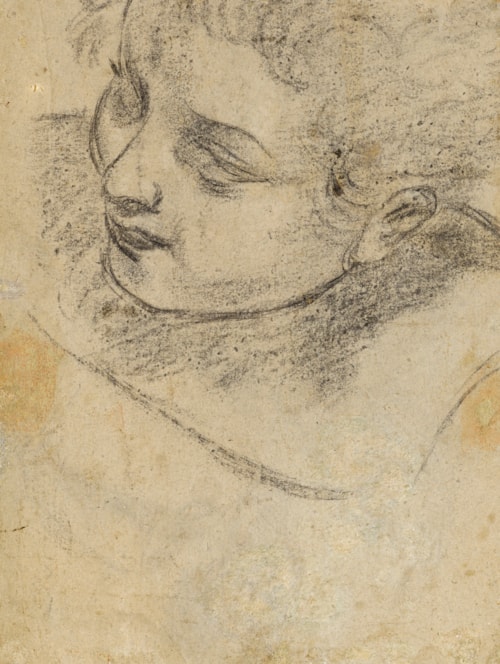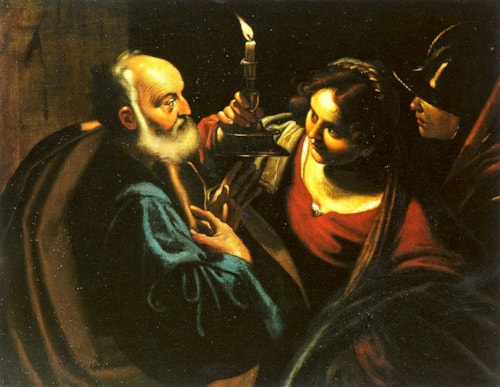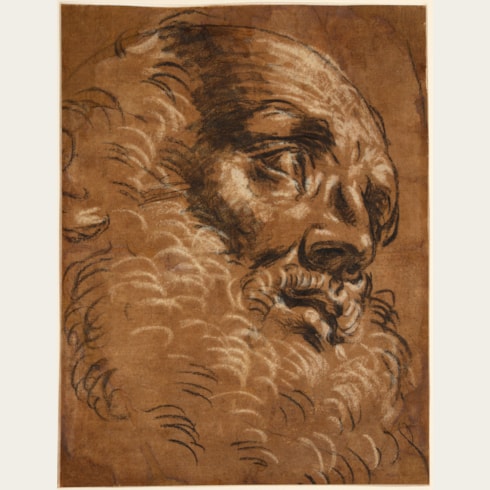Giacomo CAVEDONE
(Sassuolo 1577 - Bologne 1660)
A Man Rowing [recto]; The Head of a Woman, Looking to the Left [verso]
Black chalk, heightened with touches of white chalk, on pale blue-grey paper.
The verso in black chalk.
A small made-up area near the upper left edge.
340 x 262 mm. (13 3/8 x 10 3/8 in.)
The verso in black chalk.
A small made-up area near the upper left edge.
340 x 262 mm. (13 3/8 x 10 3/8 in.)
This large and striking study of a male figure is a fine and typical example of Giacomo Cavedone’s bold draughtsmanship. The artist would have been exposed to the practice of making such chalk studies from the posed model at the Carracci academy. Although his biographer Cesare Malvasia notes that Cavedone made a careful study of the works of Annibale Carracci, it is the influence of Ludovico Carracci that is much more evident in the artist’s mature work. Several of Cavedone’s drawings are, in fact, directly inspired by figures in Ludovico’s paintings, and the recto of the present sheet is one such example. This drawing finds its direct source in the boatman in Ludovico Carracci’s painting of The Return from the Flight into Egypt, in a private collection in Bologna, which is generally dated to around 1598-1600. Although at this date the young Cavedone was just embarking on his career as an independent artist, the present sheet is - as Laura Giles has pointed out – a much later work by the artist, who is unlikely to have produced such a forceful drawing as early as 1598. Nevertheless, Cavedone remained closely associated with Ludovico’s studio until the master’s death in 1619, and a number of later drawings by him attest to the continued inspiration of the elder artist. It may be, therefore, that Cavedone drew the recto of this sheet a decade or more after Ludovico’s painting was completed. Alternatively, it may be posited that The Return from the Flight into Egypt is in fact later in date than 1600; indeed, the painting has been dated by Sir Denis Mahon to after 1610 and to c.1612 by Sydney Freedberg, who also related the painting stylistically to Ludovico’s 1612 canvas of The Body of Saint Sebastian Thrown into the Cloaca Maxima in the J. Paul Getty Museum. If Ludovico’s painting of The Return from the Flight into Egypt is in fact a work of c.1610-1612, it may be further supposed that, as one of his chief collaborators at this point, Cavedone could have been tasked by Ludovico with developing the pose of the boatman in the painting; it is interesting to note that there is no known drawing by Ludovico Carracci for any part of the composition. As Laura Giles has noted of such figure studies as this by Cavedone, in comparison with drawings of male nudes by Ludovico Carracci, ‘if more rugged and even clumsy by comparison, Cavedone’s stolid nudes are both more convincing as representations of brute force and more consistently abstract (and austerely so) in character.’ A stylistically comparable drawing of a muscular male figure by Cavedone is in the Uffizi in Florence and another is in the collection of the Nationalmuseum in Stockholm; the latter is a study for an altarpiece of The Temptation of San Anthony, datable to c.1607, in the church of San Benedetto in Bologna. The head on the verso of this drawing is a study, as Giles has pointed out, for the woman holding a candle, with her face half in shadow, in Cavedone’s painting of The Denial of Saint Peter in the Museo Davia Bargellini in Bologna. The painting, whose earlier provenance remains unknown, has been variously dated to between 1616 and 1618 (by Giles and Renato Roli) and c.1625-1626 (by Emilio Negro and Nicosetta Roio). Giles further suggests that the composition of the picture may have been inspired by a lost painting of the subject by Ludovico Carracci recorded by Malvasia, but of which no record of its appearance survives.
Giacomo Cavedone entered the Carracci academy in Bologna in 1591, studying initially with Annibale Carracci. After Annibale’s departure for Rome in 1595, Cavedone remained in Bologna, becoming one of Ludovico Carracci’s chief assistants. He continued to work with Ludovico until the latter’s death in 1619, collaborating on such projects as the decoration of San Michele in Bosco. Cavedone’s first known independent painting is a Saint Stephen in Glory of 1601, today in the Galleria Estense in Modena. In 1609 he travelled to Rome, where he assisted Guido Reni on the decoration of the Cappella Paolina in Monte Cavallo. The influence of this Roman sojourn, and particularly his exposure to the work of Caravaggio, is reflected in such paintings as The Baptism of Christ of c.1611-1612, in the church of San Pietro Martire in Modena.
Cavedone painted several monumental altarpieces for churches in and around Bologna, and the effects of a trip to Venice between 1612 and 1613 can be seen in the painterly richness of works such as the large Sant’Alò altarpiece of 1614, now in the Pinacoteca Nazionale in Bologna. Having inherited the title of caposindaco of the Accademia degli Incamminati after the death of Ludovico Carracci, Cavedone spent the next few years of his career busy with commissions for frescoes, altarpieces and easel pictures. However, injuries sustained as a result of a fall from scaffolding in 1623, together with the loss of his wife and children to the plague of 1630, seems to have ended his career prematurely, and he produced very little work in the thirty years remaining before his death.
Cavedone’s drawings display a distinctive combination of Venetian and Bolognese elements, with the particular influence of the draughtsmanship of Titian on the one hand and Ludovico Carracci on the other. His drawings may be divided into three main groups - compositional sketches, figure and drapery studies, and large studies of individual heads - and approximately half of his surviving drawings may be related to extant paintings. While his composition drawings were generally drawn in pen and ink wash, for figure and head studies he tended to use either a soft black chalk, usually applied on blue paper, or charcoal heightened with white chalk on light brown (and sometimes oiled) paper. (Cavedone’s drawings of this latter type were to be a strong influence on Guercino’s draughtsmanship.) The largest and most important single group of drawings by Cavedone, numbering just under seventy sheets, is in the collection of the Royal Library at Windsor Castle.
Provenance
Anonymous sale, London, Christie’s, 13 December 1984, lot 39
Hazlitt, Gooden & Fox, London
Anonymous sale, New York, Sotheby’s, 12 January 1990, lot 146.

